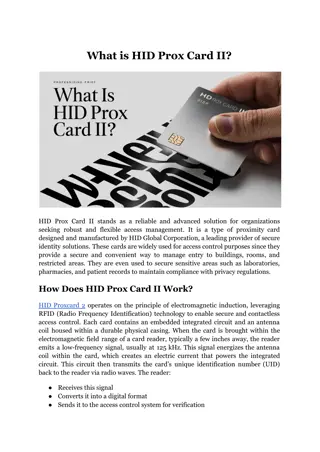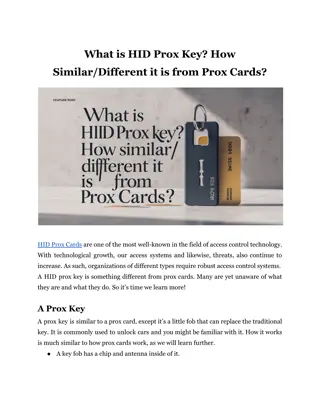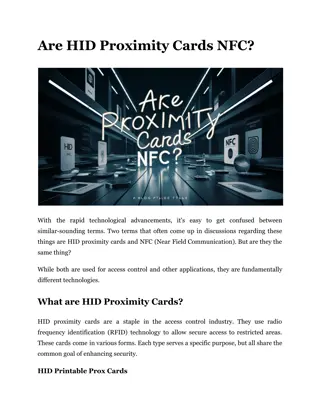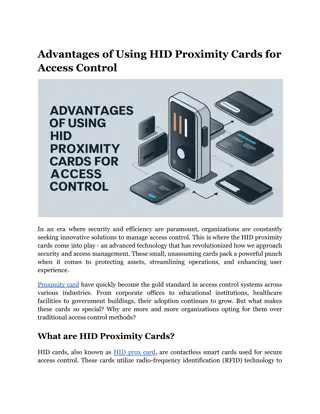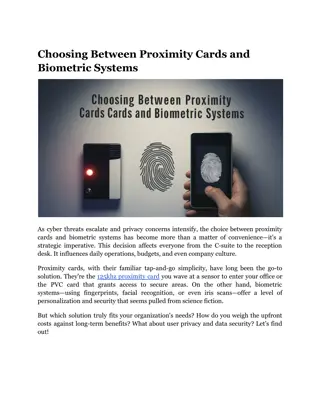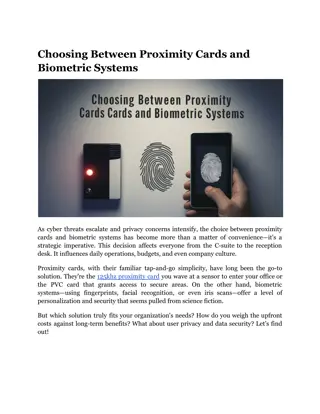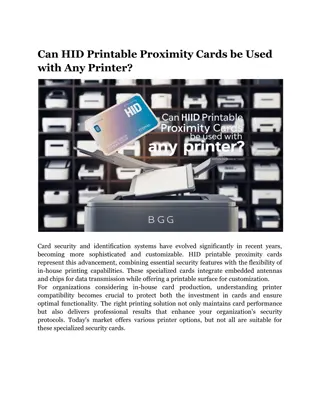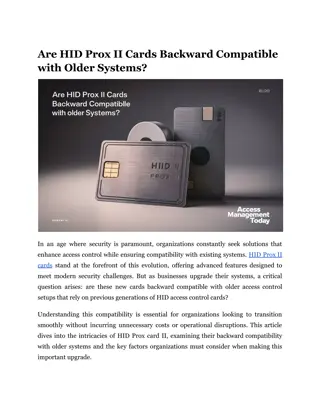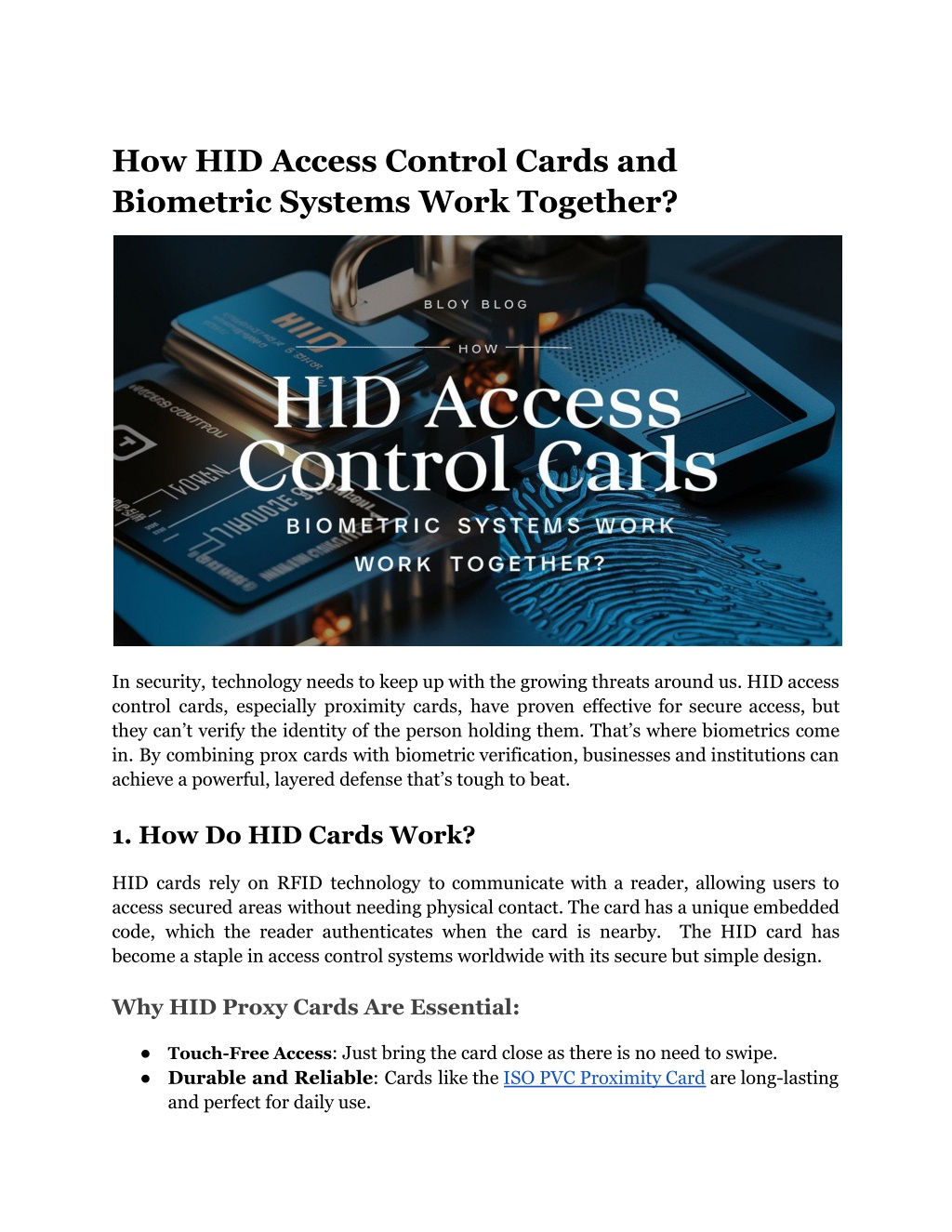
How HID Access Control Cards and Biometric Systems Work Together_
Explore how HID cards and biometrics work together for secure, seamless access control, enhancing safety in modern workplaces and facilities.
Download Presentation

Please find below an Image/Link to download the presentation.
The content on the website is provided AS IS for your information and personal use only. It may not be sold, licensed, or shared on other websites without obtaining consent from the author. Download presentation by click this link. If you encounter any issues during the download, it is possible that the publisher has removed the file from their server.
E N D
Presentation Transcript
How HID Access Control Cards and Biometric Systems Work Together? In security, technology needs to keep up with the growing threats around us. HID access control cards, especially proximity cards, have proven effective for secure access, but they can t verify the identity of the person holding them. That s where biometrics come in. By combining prox cards with biometric verification, businesses and institutions can achieve a powerful, layered defense that s tough to beat. 1. How Do HID Cards Work? HID cards rely on RFID technology to communicate with a reader, allowing users to access secured areas without needing physical contact. The card has a unique embedded code, which the reader authenticates when the card is nearby. become a staple in access control systems worldwide with its secure but simple design. The HID card has Why HID Proxy Cards Are Essential: Touch-Free Access: Just bring the card close as there is no need to swipe. Durable and Reliable: Cards like the ISO PVC Proximity Card are long-lasting and perfect for daily use.
Unique Authentication: Each card holds a specific code, which makes duplication tough. 2. The Role of Biometrics: The Who You Are Factor HID cards verify what someone has, but biometrics verify who they are. By scanning unique traits such as fingerprints, iris patterns, or facial features the biometric systems add a layer of identity verification that can t be duplicated or forged. This form of authentication has become critical for organizations handling sensitive data, valuable assets, and restricted areas. Key Biometric Methods: Fingerprint Scans: Matches a user s unique fingerprint patterns. Facial Recognition: Analyzes facial structure for a secure match. Iris Recognition: Uses the complex patterns of the iris, offering high precision. 3. HID and Biometrics: How They Create Dual Verification When HID cards and biometrics work together, the security impact is powerful. This dual-verification process requires both possession of the card and biometric verification. It s known as two-factor authentication. Here s how it works: the user first presents their HID card to the reader, and then the system prompts for biometric input, such as a fingerprint. Only after both checks are confirmed is access granted. Step-by-Step Dual Verification: 1. Card Check: The HID Prox Card is scanned and verified. 2. Biometric Prompt: The system requests a fingerprint, iris scan, or facial recognition. 3. Identity Match: Biometric data is matched to the user profile. 4. Access Granted: Only with both successful checks does the door unlock. This method is designed to prevent unauthorized access even if someone manages to steal a card. They still won t pass the biometric check, creating a multi-layered defense.
4. Dual Verification: Why Its a Security Game-Changer Relying on a single access card leaves a security gap. What happens if the card is lost or stolen? Dual verification closes this gap. Requiring both the card and a biometric match ensures that only the authorized person can enter. This combination significantly reduces risks and helps businesses meet higher security standards. Key Benefits of Combining HID Cards with Biometrics: Security: Requires both physical possession and personal Enhanced identification. Reduces Card Risks: Lost or stolen cards can t be used without the matching biometric. Meets High-Security Demands: Essential for sectors like finance, healthcare, and government. 5. The Technology Behind HID Proximity and Biometrics The technology within HID cards is simple but powerful. Each card uses encrypted RFID signals that are difficult to intercept. Leading proximity card manufacturers continuously improve these designs, tamper-resistant. On the biometric side, advanced scanners capture precise data that is encrypted and linked with access control software. making them durable, secure, and How They Work Together: RFID Encryption: Secures card data from interception or duplication. Biometric Algorithms: High-resolution scanners and advanced algorithms verify personal traits. Integrated Access Software: Manages and matches proximity and biometric data for secure, seamless access. 6. Privacy, Usability, and Trust Some users worry about privacy or data security in a dual-verification system. HID and biometric integrations address this with data encryption and strong privacy protocols, ensuring that personal information is kept safe. User-friendly systems and clear instructions help make this technology approachable, even for users unfamiliar with biometrics. Addressing Common Concerns:
Privacy: Biometric data is encrypted and stored securely. Data Protection: Centralized systems use strict security protocols. Ease of Use: Training can help users get comfortable with the two-step process. 7. Real-World Applications: Who Benefits Most from HID and Biometrics? High-security sectors such as government, healthcare, and data centers have the most to gain from dual-verification systems. Whether it s protecting patient records, safeguarding critical infrastructure, or securing sensitive data, this layered security approach meets the demands of today s complex threat landscape. Industries Benefiting from HID and Biometric Integration: Government Facilities: Secures restricted and classified areas. Healthcare: Limits access to sensitive areas like patient records or labs. Data Centers: Controls access to rooms housing valuable information. Financial Institutions: Protects high-security areas like vaults and records rooms. 8. The Importance of Working with Manufacturers Finding the right proximity card manufacturer ensures that the system is high-quality, secure, and built to last. Manufacturers offer a range of options, from basic HID prox cards to enhanced cards that work seamlessly with biometric systems. Benefits of Manufacturer Partnerships: Customized Solutions: Manufacturers can design cards tailored to specific security needs. Reliable Integration: Ensure that proxy cards work smoothly with biometric systems. Ongoing Support: Trusted manufacturers provide support and updates for secure access. 9. Tracking Performance: How to Measure Success Monitoring performance is essential to know if your dual-verification system is effective. Key metrics, such as successful access rates and unauthorized entry attempts, offer
valuable feedback for refining the system. This data can help identify weak spots and optimize security measures. Key Metrics to Track: Access Rates: Shows how effectively authorized users can enter. Unauthorized Attempts: Alerts to possible security threats. User Feedback: Helps improve usability and address concerns. Your Call Combining HID proximity cards with biometrics builds a security system that s resilient, easy to use, and extremely effective. Integrating these technologies means preparing for security that works now and into the future. It s a powerful approach that combines convenience with the peace of mind only advanced security can offer. At Bristol ID Technologies, we specialize in creating innovative, high-quality access solutions that go beyond the standard. Explore high-performance, custom cards designed to elevate your access control. Get Started with a Solution Built for Security. Contact Us Today! Site Article: How HID Access Control Cards and Biometric Systems Work Together?





